Margaret Bruton | |
|---|---|
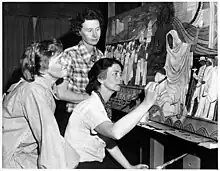 Seated in the foreground is Esther Bruton; Helen Bruton is wielding the brush; while Margaret Bruton stands. | |
| Born | Margaret Bell Bruton February 20, 1894 Brooklyn, New York, U.S. |
| Died | August 29, 1983 (aged 89) Monterey, California, U.S. |
| Education | Mark Hopkins Institute of Art, Art Students' League, Académie de la Grande Chaumière |
| Known for | Painting, murals, printmaking |
Margaret Bell Bruton (February 20, 1894 – August 29, 1983) was an American painter, muralist, and printmaker known for her contributions to the Californian art scene.
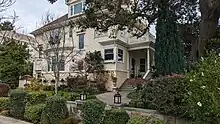
Early life
Margaret Bruton was born to Daniel Bruton (1839–1928) of Dublin, Ireland, and Helen Bell (1866–1956) of Belfast, Ireland. Daniel, an employee at the American Tobacco Company, eventually moved the family to San Francisco, California. Margaret was the eldest of three sisters, including Anne Esther Bruton Gilman (1896–1992) and Helen Bruton (1898–1985). She grew up attending public schools in Alameda, California. As a successful tobacco merchant, Daniel commissioned Denis Straub & Son to construct the family home at 1240 St. Charles Street in Alameda. This house was sold by the family in 1944.[1]
Education and early career
Bruton's artistic journey began at the Mark Hopkins Institute of Art (later known as San Francisco Art Institute) in San Francisco in 1913, where she studied under Frank Van Sloun. In 1913 she won a scholarship during the 10th annual scholarship competition organized by the Art Students League of New York.[2] There, she honed her skills under the guidance of artists Robert Henri and Frank Vincent Dumond from 1914 to 1918.
During World War I, Bruton contributed to the war effort by serving as an occupational therapist at Letterman Hospital in San Francisco. She, along with her sisters and mother, established a studio in the attic of their Alameda home.
Early Monterey period (1922–1929)
There were two periods when Margaret Bruton resided in Monterey, California. In the early 1920s, Bruton moved to Monterey, California, attracted by the scenic beauty and the opportunity to study with artist Armin Hansen. The Bruton family eventually settled there, building a house and studio[3]: 52 and stayed in it "on and off" as it was their summer place and "Monterey was small and simple at that time".[4] Margaret's sister Helen Bruton recalled:[5]
"[..] we were here in Monterey from about 1922 to 1929, and that’s what I consider the golden age of Monterey from my standpoint because it was so lovely and there was such an interesting group of artists here at the time. It was a very stimulating period. Of course, Armin Hansen had a class and a lot of the younger people gravitated around his class, but there were others. There was Price, and Gay, and the other people who were painting on their own, and I was on the fringe, sculpting, supposedly."
She was associated with the Monterey Group of painters who were meeting at the Stevenson's House. Some of them were associated with the Society of Six.[6]
Bruton gained recognition through various exhibitions, such as a group exhibition at the Los Angeles Museum in 1923 where she won a $100.00 prize. She also received accolades at the Santa Cruz Art League in 1925. She and her sisters undertook several travels, visiting England, France, Italy. In about 1929, she embarked on an artistic expedition to New Mexico (Taos and Santa Fe). [7]: 49 Margaret spent a year studying at the Académie de la Grande Chaumière in Paris.
Margaret and her sisters were lifelong friends of Ina Perham.[1]: 165 They traveled to Virginia City in September of 1932 where they worked together.[1]: 61 They would wake up at 6.30 in the morning and begin to work at 8 or "a little later". [8]: 37:55
Mosaic and terrazzo art
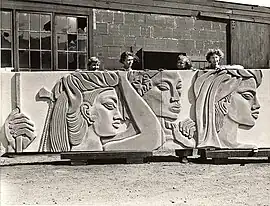
In 1930 she ventured into the world of mosaics working on projects supported by Public Works Administration and Works Progress Administration.
The exterior mosaic panels for the Fleishacker Zoo Mother House in San Francisco, a project under the Federal Art Project, were primarily envisioned by Helen, with her sister Margaret playing a supportive role in their creation. This endeavor began at the close of 1933, utilizing local materials and with the technical assistance of Antonio (Anthony) Falcier, an Italian mosaicist with prior experience from his work on the Neptune Pool at Hearst Castle in San Simeon.
Together with her sisters she created The Peacemakers, a historic mural for the 1939 Golden Gate International Exposition. Housed within Timothy Pflueger's Court of Pacifica, the mural was a dramatic work spanning 144 feet wide by 57 feet tall, representing the collaborative peace between the countries of the East and West. The mural combined elements from Eastern and Western cultures, symbolizing peace across the Pacific. At its center stood two large figures, a Buddha and a kneeling woman, flanked by friezes of 24-foot tall figures and famous architectural landmarks. The Bruton sisters utilized a unique technique, carving the design into masonite panels to create a bas relief effect, allowing for depth and shadow play when illuminated.
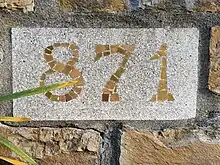
After selling their Alameda house in 1944, they moved to Monterey, to the house that their family had originally built in the mid-1920s. [9][10]
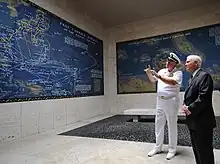

In the 1950s Bruton sisters worked for 3 years on approx. 22 mosaics and terrazzo maps for the memorial at the Manila American Cemetery.[11][9] The maps, were created using information from the American Battle Monuments Commission, were produced by the P. Grassi American Terrazzo Company in South San Francisco. Made from tinted concrete with vibrant colored aggregates, they incorporate military data through mosaic or ceramic details. The borders and compass designs reference Pacific Islands' art styles, and accompanying descriptive texts, made of plastic, elaborate on the maps' details.[12] The Margaret Bruton Collection, housed in the Mayo Hayes O'Donnell Library Doud House Archive Storage in Monterey, contains photo prints of 27 of these maps.[13] There maps were on display in the gallery of the New Monterey Neighborhood Center in 1966; this exhibition which offered a unique collection of photographic reproductions and original works in a variety of media by the Brutons. [14]
In October–November, 1952 in the de Young Museum's during the "Contemporary Religious Art by California Artists" exhibition Margaret presented terrazzo work "Station XII".


She created a Monterey Harbour plaque with the characteristic signature MB. The marker is located to the east of the entrance to the Fisherman's Wharf.
Margaret Bruton created terrazzo tables including some for clients of Frances Elkins who had her design studio in the Robert Louis Stevenson House (Casa Blanca) in Monterey between 1927 and 1947.[15]
Associations and legacy
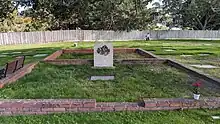
Margaret was an active member of several art societies including the San Francisco Society of Women Artists, the Club (Galerie) Beaux Arts (116 Maiden Lane)[16], California Society of Etchers, San Francisco Art Association, and the Progressive California Painters and Sculptors.
Throughout her career, Bruton was a part of multiple exhibitions, including group shows at the Club Beaux Arts, Bullock’s Little Gallery, and the Weyhe Gallery. In 1935, she had a retrospective exhibition at the Oakland Gallery.
Her works have been honored with numerous awards and are housed in collections at the Monterey Museum of Art, Oakland Museum of California, and the San Diego Museum of Art.
Death
Margaret Bell Bruton died in Monterey, California on August 29, 1983. She was cremated at the Little Chapel by-the Sea which was followed by inurnment. Her resting place is Cemetery El Encinal in Monterey, California. [17]
References
- 1 2 3 Good, W. V. W. (2021). Sisters in Art: The Biography of Margaret, Esther, and Helen Bruton. West Margin Press. ISBN 978-151-328-9519.
- ↑
Simons, T. L. Fitz (June 1913). "The competition of the Art Student's League". Arts and Decorations: 282.
{{cite journal}}: CS1 maint: date and year (link) - ↑ "Helen Bruton". California Art Research, Volume Sixteen, First Series, Abstracts from the WPA project 2874 (PDF). 1937. pp. 51–67.
- ↑ "Interview with Helen Bruton, Margaret Bruton, and Edith Hamlin. Videorecordings relating to New Deal art in California, 1975-1976. February 27th, 1975. Creator: de Saisset Museum, Santa Clara University. Tape 1". Retrieved October 23, 2023.
- ↑ "Oral history interview with Helen and Margaret Bruton, 1964 December 4 (An interview of Helen and Margaret Bruton conducted by Lewis Ferbraché on 1964 December 4 for the Archives of American art New Deal and the Arts Project.)". Retrieved October 21, 2023.
- ↑ Boas, Nancy (1997). The Society of Six: California Colorists. University of California Press.
- ↑ Burns, Sarah (2005). "Chapter 2: Fabricating the Modern: Women in design". In Wardle, Marian (ed.). American Women Modernists: The Legacy of Robert Henri, 1910-1945. Rutgers University Press. pp. 30–56.
- ↑ William Lorton (Director) (2020). Ina's Circle (Documentary). United States: DAvenport 3-2614.
- 1 2 Jerram, Elise (December 18, 1977). "Bruton sisters look back, reluctantly". The Sunday Peninsula Herald. Section "Peninsula Life".
- ↑ Documentary movie "Ina's Circle" has a picture comparing this house in mid-1920s and after 1944.
- ↑ "Interview with Helen Bruton, Margaret Bruton, and Edith Hamlin. Videorecordings relating to New Deal art in California, 1975-1976. February 27th, 1975. Creator: de Saisset Museum, Santa Clara University. Tape 2". Retrieved October 23, 2023.
- ↑ American Battle Monuments Commission. (1967). Manila American Cemetery and Memorial.
- ↑ The Margaret Bruton Collection, housed in the Mayo Hayes O'Donnell Library Doud House Archive Storage, contains photo prints in flat files within Drawer 14, items 1 through 27 (some repeating). The collection includes: 1. "Defense of Luzon," 10 x 15, 2. "Defense of Luzon," 15 x 15, 3. "General Strategy of Pacific," 4. "General Strategy of Pacific," 5. "U.S.S. Submarine Operation," 6. "Liberation of Philippines," 7. "Battle for Leyte Gulf," 8. "The Mariana," photo print, 9. "Iwo Jima," photo print, 10. "Invasion of Palau Island," 11. "Return to Philippines," 12. "Return to Philippines," 13. "Battle of Philippines Sea," 14. "Okinawa," 15. "Defense of S/E Asia," 16. "War Against Germany," 17. "War Against Germany," 18. "War Against Germany," 19. "China-Burma-India," 20. "China-Burma-India," 21. "Battle of Coral Sea," 22. "Battle of Midway," 23. "Luzon Campaign," 24. "Northern Solomon's," 25. "Goudal Canal," 26. "Air Assault on Japan," and 27. "New Guinea." Together, these pieces offer a visual journey through significant military events and strategies.
- ↑ Alexander, Irene (1966-12-14). "Bruton Sisters Work Shown". Monterey Peninsula Herald.
- ↑ Powell, Scott (2023). "Ellen Nidy (Editor)". Frances Elkins: Visionary American Designer. New York, NY: Rizzoli. p. 303. ISBN 9780847865468. OCLC 1371424502.
- ↑ Beaux Arts Galerie was a cooperative nonprofit gallery active from 1925 to 1933.
- ↑ "Margaret Bruton". Monterey Peninsula Herald. September 1, 1983. p. 4.